Dragon Quest, previously published as Dragon Warrior in North America until 2005, is a series of role-playing games created by Japanese game designers Armor Project, Bird Studio and Sugiyama Kobo to its publisher Enix, with all of the involved parties co-owning the copyright of the series since then. The games are published by Square Enix since its inception, with localized remakes and ports of later installments for the Nintendo DS, Nintendo 3DS, and Nintendo Switch being published by Nintendo outside of Japan. With its first game published in 1986, there are eleven main-series games, along with numerous spin-off games. In addition, there have been numerous manga, anime and novels published under the franchise, with nearly every game in the main series having a related adaptation.
The Slime series is a spinoff series of games from Dragon Quest featuring its Slime character. Three games have been released, the second of which, Dragon Quest Heroes: Rocket Slime, has been released in North America.
Dragon Quest Monsters is a spin-off series of the Dragon Quest games. Primarily developed by Tose and published by Square Enix, it sets the player in a medieval/fantasy world filled with magic, monsters and knights. Unlike the original Dragon Quest games, the player's character does not do any of the fighting in battles; instead the player has to rely on capturing, breeding and raising monsters to do the fighting for them. The concept originated from Dragon Quest V (1992). The character and monster designs are by Dragon Ball creator, Akira Toriyama. The series spans several handheld gaming systems, and each game has received positive reviews from critics. The series' gameplay has been compared to Pokémon.

Dragon Quest VII: Fragments of the Forgotten Past is a 2000 Japanese role-playing video game developed by Heartbeat and ArtePiazza, and published by Enix for the PlayStation. It was released in North America in 2001 under the title Dragon Warrior VII. The game received a remake on the Nintendo 3DS in Japan in 2013, released in English under the title Dragon Quest VII: Fragments of the Forgotten Past in 2016. A version of the game for Android and iOS was released in Japan in 2015.

Dragon Quest II: Luminaries of the Legendary Line, titled Dragon Warrior II when initially localized to North America, is a role-playing video game developed by Chunsoft and published by Enix in 1987 for the Nintendo Entertainment System as a part of the Dragon Quest series. Enix's U.S. subsidiary published the American release, Dragon Warrior II, for the Nintendo Entertainment System in 1990. Dragon Quest II is set one hundred years after the events of the first game.
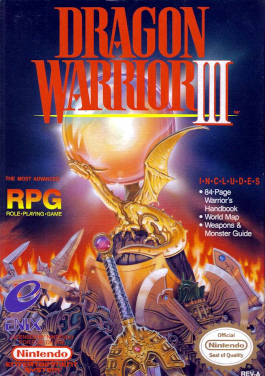
Dragon Quest III: The Seeds of Salvation, titled Dragon Warrior III when initially localized to North America, is a 1988 role-playing video game developed by Chunsoft and published by Enix. It is the third installment in the Dragon Quest series and was first released for the Family Computer (Famicom) in Japan and later for the Nintendo Entertainment System (NES) in North America. The game saw an enhanced remake for the Super Famicom in 1996 and the Game Boy Color in 2001, and a port to mobile phones and the Wii in 2009 and 2011. A version of the game for Android and iOS was released in Japan on September 25, 2014, and worldwide as Dragon Quest III: The Seeds of Salvation on December 4, 2014. It was the first time the game was given an official English subtitle. Later in 2021, another remake of the game titled Dragon Quest III HD-2D Remake, based on Octopath Traveler's style, was announced during the franchise's 35th anniversary livestream.

Dragon Quest VI: Realms of Revelation, known in Europe as Dragon Quest VI: Realms of Reverie, is a role-playing video game developed by Heartbeat and published by Enix for the Super Famicom as a part of the Dragon Quest series and as the last Dragon Quest game in the Zenithian Trilogy. It was released in Japan in December 1995, developed by Heartbeat; whereas the previous Dragon Quest games were developed by Chunsoft. In 2011, a remake of the game, along with Dragon Quest IV and Dragon Quest V, was released worldwide for the Nintendo DS, making this the first time the game was released in English. Another version of the game for Android and iOS devices was released in Japan in June 2015.

Dragon Quest VIII: Journey of the Cursed King is a role-playing video game developed by Level-5 and published by Square Enix for the PlayStation 2. It was released in Japan in 2004, in North America in 2005 and PAL regions in 2006, making it the first main series installment released in the PAL region. It is the eighth installment of the Dragon Quest series and it is the first English version of a Dragon Quest game to drop the Dragon Warrior title. A version of the game for Android and iOS was released in Japan in December 2013, and worldwide in May 2014.

Dragon Quest Monsters: Caravan Heart is the third game in the Dragon Quest Monsters series, released only in Japan by Enix for the Game Boy Advance. The game was simultaneously announced with Dragon Quest VIII in Famitsu in 2002. Like the other Dragon Quest titles, development of Caravan Heart was led by Yuji Horii.
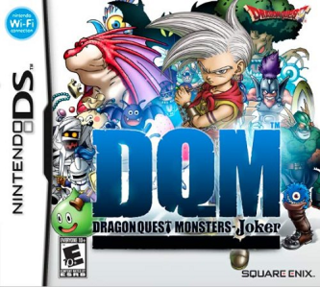
Dragon Quest Monsters: Joker is a 2006 role-playing video game developed by Tose and published by Square Enix for the Nintendo DS. It is the fourth installment of the Dragon Quest Monsters series. This was the first game in the series to have online play, done using Nintendo Wi-Fi. A sequel, Dragon Quest Monsters: Joker 2, was released in 2010.
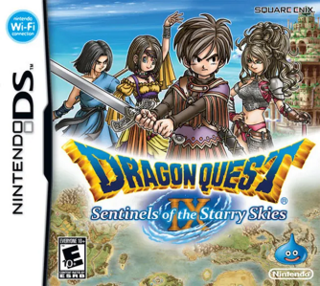
Dragon Quest IX: Sentinels of the Starry Skies is a role-playing video game co-developed by Level-5 and Square Enix for the Nintendo DS. Published by Square Enix in Japan in 2009, and by Nintendo overseas in 2010, it is the ninth mainline entry in the Dragon Quest series. The storyline follows the protagonist, a member of the angelic Celestrian race, after a disaster in their home scatters magical fruits across the mortal realm. While carrying over traditional gameplay from the rest of the series with turn-based battles, the game is the first Dragon Quest entry to feature a customizable player character, and the first to include a multiplayer mode, with the option of trading treasure maps and loaning player characters through Nintendo Wi-Fi. Online functions ended in 2014 when it ceased operations.
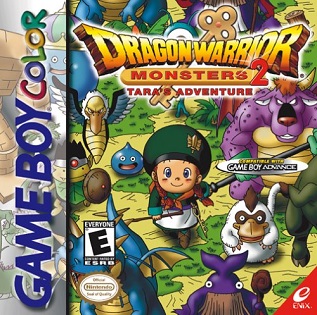
Dragon Warrior Monsters 2, known in Japan as Dragon Quest Monsters 2, is a role-playing video game published by Enix for the Game Boy Color. It is the second Dragon Warrior Monsters game for the Game Boy Color and features two different versions of the same game, Cobi's Journey and Tara's Adventure. Both games were remade in 2002 for the PlayStation in a compilation game called Dragon Quest Monsters 1+2 and released only in Japan. The Nintendo 3DS version combined both games into one and was released only in Japan in 2014 with the title Dragon Quest Monsters 2: Iru and Luca's Marvelous Mysterious Key. The 3DS version was later brought to iOS, Android on August 6, 2020, in Japan.

Dragon Quest X: Rise of the Five Tribes Online, also known as Dragon Quest X Online, is a massively multiplayer online role-playing game (MMORPG) developed and published by Square Enix. It is the tenth mainline entry in the Dragon Quest series. It was originally released for the Wii in 2012, and was later ported to the Wii U, Windows, PlayStation 4, Nintendo Switch, Android, iOS, and Nintendo 3DS, all of which support cross-platform play. Other than a discontinued Windows version in China, the game was not released outside of Japan. A single-player remake, titled Dragon Quest X Offline, was released in 2022 in Japan. It is also set to release in other Asian regions in 2024.

Dragon Quest Wars is a 2009 turn-based strategy video game developed by Intelligent Systems and published by Square Enix for the Nintendo DSi via its DSiWare download service. It is part of the Dragon Quest series and supports up to three other players in multiplayer.
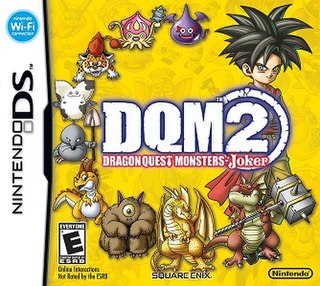
Dragon Quest Monsters: Joker 2 is a 2010 role-playing video game developed by Tose and published by Nintendo for the Nintendo DS. It is the sequel to Dragon Quest Monsters: Joker (2006) and is the fifth game in the Dragon Quest Monsters series. A sequel, Dragon Quest Monsters: Joker 3, was released in 2016.

Slime Mori Mori Dragon Quest 3: Daikaizoku to Shippo Dan is a 2011 action-adventure game by Square Enix for the Nintendo 3DS. It is a spinoff video game to the Dragon Quest series, and the third entry in the Slime subseries. The game has not seen an official English release, but a fan-made translation patch has been made available.
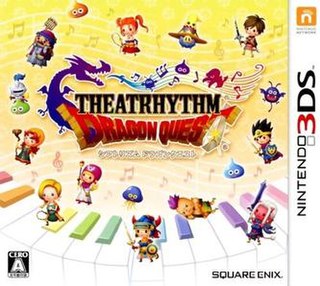
Theatrhythm Dragon Quest is a rhythm game developed by indieszero and published by Square Enix for the Nintendo 3DS. It was released in Japan on March 26, 2015, and was the first game of its type in the Dragon Quest series and the third Theatrhythm game after Theatrhythm Final Fantasy and Theatrhythm Final Fantasy: Curtain Call.

Dragon Quest XI: Echoes of an Elusive Age is a role-playing video game by Square Enix. The eleventh entry in the long-running Dragon Quest video game series, it was released in Japan for the Nintendo 3DS and PlayStation 4 in July 2017 and worldwide for the PlayStation 4 and Windows in September 2018. An enhanced version, Dragon Quest XI S: Echoes of an Elusive Age - Definitive Edition, was released for Nintendo Switch by Nintendo in September 2019; for PlayStation 4, Windows, and Xbox One in December 2020; and for Stadia in March 2021.

Dragon Quest Monsters: Joker 3 is a 2016 role-playing video game developed by Tose and published by Square Enix for the Nintendo 3DS. It is the sequel to Dragon Quest Monsters: Joker 2 (2010), and is the sixth game in the Dragon Quest Monsters series.
















